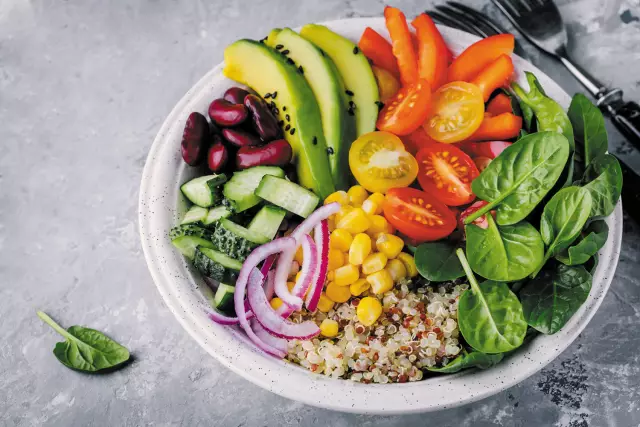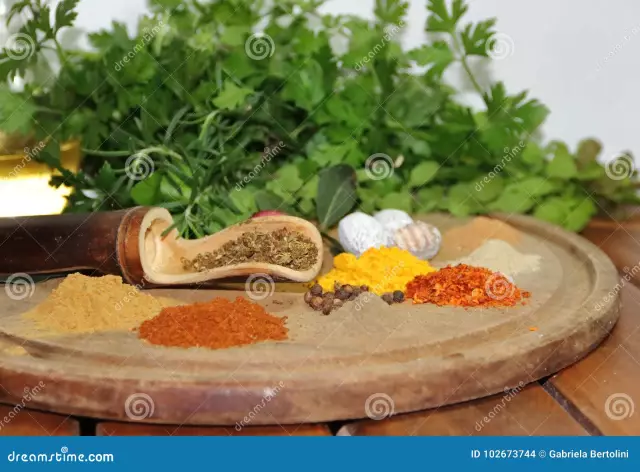- Author Rachel Wainwright [email protected].
- Public 2023-12-15 07:39.
- Last modified 2025-11-02 20:14.
Ayurvedic Traditions: 10 Healthy Spices
Ayurveda is an ancient practice that came to us from India, the doctrine of maintaining the physical, psychological and moral health of a person using a complex of procedures, including diet, body cleansing, breathing exercises, massage, and in case of illness and drug therapy. Ayurvedic healers give a very important role to spices. Ayurvedic medicines, as a rule, are based on them. It is believed that spices not only improve the taste of dishes, but also affect the mental and state of mind of a person, and are also powerful means of fighting the most severe ailments.
Today we propose to get acquainted with the spices and seasonings most common in Ayurvedic practice.
Cinnamon
This is the dried bark of young shoots of Ceylon cinnamon, an evergreen tree originally grown exclusively in Sri Lanka. Nowadays, cinnamon is grown in many tropical countries. The spice is sold in the form of small pieces of bark or powder.
Cinnamon has a surprisingly pleasant aroma that creates a feeling of comfort, peace and warmth. It contains cinnamal (cinnamaldehyde), which is a natural relaxant. It is because of its effect on the body that cinnamon (and cinnamon oil) is widely used in aromatherapy to relieve the effects of stress, reduce the nervousness and anxiety of patients. In addition, cinnamon contains substances with strong antioxidant and antibacterial properties.
Real cinnamon is very expensive. Often, instead, they sell whole or ground bark of another plant - cassia, or Chinese cinnamon. This seasoning has a different chemical composition and less pronounced aroma. But cassia bark has clinically proven antidiabetic properties.
It is very easy to distinguish real cinnamon: in general, its strips have a delicate, loose structure with a layer thickness of 0.5-0.7 mm (for dried cassia bark, the layers are 2-3 mm thick). Cinnamon powder can be tested with a drop of iodine tincture. The bark of cassia contains a large amount of starch, and the powder made from it turns blue under the influence of iodine. This does not happen with real cinnamon.
Cinnamon should not be used with a tendency to internal bleeding, increased excitability, hypertension. You should not get carried away with the spice during pregnancy, as cinnamon can increase the tone of smooth muscles, which creates the risk of miscarriage.

Source: depositphotos.com
Turmeric
The spice is made from the rhizomes of plants of the ginger family. Each of them contains curcumin, a natural dye (yellow or yellow-orange). This substance is an antioxidant, enhances the production of a number of enzymes and hormones, and has a pronounced anti-inflammatory effect. Research has shown that regular use of turmeric reduces the risk of developing Alzheimer's disease and multiple sclerosis, and inhibits the growth of cancerous tumors.
Three types of turmeric are used in cooking: long (for the production of well-known condiments and spices, such as curry powder), aromatic (in the confectionery industry) and zedoaria (for the manufacture of liqueurs). In addition, turmeric powder is used as a food coloring in the production of cheeses, margarines, cookies, chips and various sauces. In home cooking, turmeric can be added to dishes made from meat, vegetables, rice, and baked goods.
Turmeric is contraindicated in pregnant women, people suffering from gastritis, pancreatitis and pathologies of the biliary tract.

Source: depositphotos.com
Ginger
Ginger root is widely used in oriental cuisine fresh, dried (powder) and pickled, as well as jam or candied fruit. It contains substances that normalize metabolism and improve the condition of the digestive system. Ginger root helps relieve nausea, headaches and cold symptoms. In aromatherapy, ginger oil is used to treat psycho-emotional disorders.
Among people who dream of losing weight, ginger water tincture is extremely popular as a means of optimizing metabolic processes and helping to get rid of extra pounds.
Unfortunately, not everyone can eat ginger. The list of contraindications includes:
- late pregnancy;
- high temperature, feverish conditions;
- skin ailments;
- hypertonic disease;
- cardiovascular problems;
- hemorrhoids;
- cholelithiasis;
- liver disease;
- gastritis and peptic ulcer;
- tumors of the gastrointestinal tract.

Source: depositphotos.com
Kumin (zira)
The spice has a strong antiseptic effect and contains active antioxidants. It has been proven that cumin has a beneficial effect on the processes of digestion and metabolism. It successfully relieves stomach pains, helps with flatulence and diarrhea. In addition, cumin normalizes heart function, reduces the risk of myocardial infarction, and reduces blood clotting. There is evidence that the use of Zira improves vision and activates the activity of the brain.
Cumin is the dried seed of a plant in the Umbelliferae family. In cooking, they are used whole or chopped as a seasoning for meat dishes, soups, and also as a component of hot sauces.
Zira is contraindicated for peptic ulcer and inflammatory diseases of the digestive system.

Source: depositphotos.com
Fennel
Fennel is a plant of the umbrella family. In cooking, its seeds are used to make sauces, soups, pickles. Fresh leaves are included in salads. The plant contains substances that have an antispasmodic, expectorant and antimicrobial effect. A water infusion of crushed seeds improves digestion, relieves flatulence. It is from them that "dill water" is made - a remedy that saves newborns from intestinal colic.
Fennel is not recommended for people with a tendency to epileptic seizures or heart rhythm disturbances.

Source: depositphotos.com
Coriander
Coriander is the name for the seeds of a widespread garden plant - cilantro, fresh and dried leaves of which are one of the most beloved elements of oriental and mountain cuisine. The seeds are used to make herbs, sauces, baked goods and drinks.
The spice has a choleretic effect, helps cleanse the liver and remove toxins from the body. In addition, in Ayurveda, coriander is considered a diuretic, antifungal and antiseptic. The infusion of seeds is recommended to be taken for urinary tract infections.
Coriander should not be carried away with thrombophlebitis, heart and vascular problems, diabetes mellitus, gastritis, increased acidity of gastric juice. This spice should not be used by pregnant women, lactating women, as well as those who have problems with the menstrual cycle. With excessive consumption, cilantro can harm men as well: if you eat more than 30 g of greens or 4 g of seeds per day, there is a risk of sleep problems, memory impairment and even weakening of potency.

Source: depositphotos.com
Carnation
Dried clove buds are widely used in cooking. They are included in various confectionery products, drinks, sauces, and are used for canning vegetables and fruits.
The spice contains essential oils, the most effective component of which is eugenol. It imparts antimicrobial, antiparasitic and antiseptic activity to cloves, as well as a diuretic, anti-spastic and anticonvulsant effect. It has been proven that the use of spices reduces the likelihood of attacks of bronchial asthma. Clove has a beneficial effect on digestion, relieves pain, including toothache.
It is undesirable to use cloves for people suffering from hypertension or ulcerative lesions of the stomach and intestines. In addition, the spice is not recommended for pregnant and lactating women, children under two years of age.

Source: depositphotos.com
Chilli
Hot chili is one of the most common spices. It is added to meat, fish, vegetable and cereal dishes, soups, sauces, sausages. There are many species of this plant, with fruits of different sizes, shapes and colors. When buying fresh chili, keep in mind that the finer the fruit, the sharper the taste.
Chili fruits contain capsaicin, a pungent-smelling, pungent-tasting substance that speeds up metabolism and improves digestion. It is believed that regular use of the spice can help you lose weight. In Ayurvedic practice, chili is used to activate the brain and liver, reduce the frequency of epileptic seizures and attacks of bronchial asthma. There is evidence that hot pepper inhibits the growth of malignant neoplasms.
Chile can be harmful if you have stomach and duodenal ulcers. To avoid irritation of the mucous membranes of the digestive system, pepper is not recommended for small children.

Source: depositphotos.com
Cardamom
This fruit of a perennial herb cultivated in Guatemala, India and Ceylon has a very strong aroma. Spice is added to sweets, pastries and drinks: tea and coffee with cardamom are popular in the countries of the East.
In Ayurveda, cardamom is considered a tonic and aphrodisiac, as well as a product that helps to remove mucus from the body. It is recommended for the treatment of bronchitis, colds, asthma, to improve blood circulation and get rid of "bad" cholesterol.
When buying cardamom, you should pay attention to its freshness, as the aroma fizzles out quickly. There are few contraindications to the use of cardamom: they should not get carried away by people with ulcerative lesions of the stomach and intestines.

Source: depositphotos.com
Fenugreek (fenugreek, shambhala)
Plant of the legume family. Grass and seeds are used in food, which contain a unique set of useful components. The spice has an expectorant, antipyretic, anti-inflammatory and tonic effect. It contains hormone-like substances that help normalize the condition of women during menopause. Fenugreek seeds enhance lactation, optimize blood pressure, and stimulate the digestive tract.
Fenugreek should not be used as food for pregnant women, as well as for people suffering from thyroid pathologies.

Source: depositphotos.com
Spices not only improve the taste of food. Many of them have been used since ancient times in the treatment of a wide variety of diseases, and the therapeutic effect in most cases is confirmed by both scientific research and practice. However, when using spices in food, the possibility of developing allergies must be considered. The use of an unfamiliar spice should be started with a minimum amount, carefully monitoring the body's response.
YouTube video related to the article:

Maria Kulkes Medical journalist About the author
Education: First Moscow State Medical University named after I. M. Sechenov, specialty "General Medicine".
Found a mistake in the text? Select it and press Ctrl + Enter.






